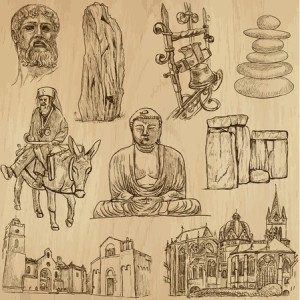Is AA Religious?
Roger C. announced in June of 2022 that his article, “The Last Post on AA Agnostica,” would be the final new article posted on the website. AA Agnostica would remain online, but there will be no more new articles. He said in the eleven years since it was launched, AA Agnostica has been a comfort for those who could not stand “all the God stuff at traditional AA meetings,” like ending with the Lord’s Prayer. “All the God stuff” makes AA religious.
Roger said he was treated with disrespect at traditional AA meetings because he didn’t believe in God and was told that without God, he would get drunk again. While that prediction did not come true, it seemed to motivate him to start the website, AA Agnostica. There are several resources in addition to its 746 other articles, including a listing of secular group websites, alternative 12 Steps and literature. There is also a link to a 2015 self-published book edited by Roger, Do Tell! Stories by Atheists and Agnostics in AA (available on Amazon). It contains thirty stories by people who do not believe that “an interventionist deity—a God—had anything at all to do with their recovery from alcoholism.”
In the first chapter of Do Tell! Stories by Atheists and Agnostics in AA, “Reshaping the AA Culture,” Roger C. pointed out that the fellowship and the book from which it gleans its name, Alcoholics Anonymous, was “mired” in the predominantly American Christian culture of the Thirties and Forties. He described how God was mentioned (in one way or another) in six of the 12 Steps. A section from “How It Works,” chapter five of the Big Book, is typically read at the beginning of an AA meeting. The reading says that “probably no human power could have relieved our alcoholism” but the God could and would do so “if He were sought.” A so-called “traditional” AA meeting ends by reciting the Lord’s Prayer.
The point he’s attempting to make is that despite various judicial decisions have found AA to be a religious organization, AA has failed to respond because it sees the rulings as “outside issues,” which he believes is incorrect. See “The Courts, AA and Religion” on the AA Agnostica website for the rulings.
He believes this is an “inside issue” that needs to be addressed by AA. However, Roger C. does not think the Big Book should be revised or rewritten. “It lays the foundation for what does work for alcoholics: the very human power of one alcoholic talking to another alcoholic.” This, he said, is what assists alcoholics in working towards “recovery from alcoholism and is the very essence of the fellowship of AA.”
It is true that U.S. Courts have ruled that AA is a “religion.” However, I think these rulings and Roger C.’s claim it is an “inside” issue to AA are based on an understanding of what constitutes a religion in modern culture that is different than what AA itself believes. Pointing to references to “God,” and saying the Lord’s Prayer as evidence that AA is religious stems from Edmund Tylor’s definition of religion as “the belief in spiritual beings.” AA seems to follow Emile Durkheim, who thought religion was a product of society and should not be defined just in terms of ideas of divinity or spiritual beings. AA also explicitly credits how its sense of religion and spirituality is drawn from William James in The Varieties of Religious Experience.
In “What Does Religious Mean?” I discussed how Tylor’s understanding seems to have influenced the legal decisions within American culture and the U.S. court system. Then I continued to unpack how William James influenced the spiritual, not religious understanding within AA in “Spiritual, not Religious Experience” and “The God of the Preachers.” I agree with AA that the Court decisions ruling that AA is religious is an outside, rather than an inside issue to the fellowship.
Some Christians, like Martin and Deidre Bobgan in 12 Steps to Destruction, make the same error, viewing AA as religious. They claim A.A. is a Christless religion, offering up a counterfeit salvation. “Because of the many versions of God represented in A.A., professing Christians are uniting themselves with a spiritual harlot when they join A.A.” In The Useful Lie, William Playfair claimed when Christians go to AA for help, they unwittingly side against Biblical Christianity.
In “Religious Alcoholics; Anonymous Spirituality,” I suggested a more helpful discussion would distinguish between true religion and mere religion; true spirituality and mere spirituality. Mere religion or mere spirituality are concepts consistent with Durkheim’s and James’ understanding of religion and spirituality (called personal religion in The Varieties of Religious Experience, VRE).
The emptiness of ritual or worship (mere religion) without a heart for God (true spirituality) is noted in Hosea 6:6, “For I desire steadfast love and not sacrifice, the knowledge of God rather than burnt offerings.” Again, the same contrast appears in Micah 6:7-8, “For You will not delight in sacrifice or I would bring it; you will not be pleased with a burnt offering. The sacrifices of God are a broken spirit; a broken and contrite heart, O God, You will not despise.” True religion always contains true spirituality.
At its best, Twelve Step spirituality rises only to the level of general revelation or common grace. There is a God and sobriety is better than drunkenness. True spirituality requires that we confess with our mouth that Jesus is Lord and believe in our heart that God raised Him from the dead (Rom. 10:9). True spirituality requires true religion. In his book, “True Spirituality,” Francis Schaeffer rejected the possibility of true spirituality devoid of biblical content. There cannot be a leap-in-the-dark faith for a Christian; there is no “faith in faith” encounter with the divine.
Twelve Step spirituality is nothing more than common grace or mere spirituality. Following the thought of William James in VRE, it rejects institutional religion, which he defined worship, sacrifice, ritual, theology, ceremony and ecclesiastical organization. Personal religion/spirituality for his purposes, was “the feelings, acts and experiences of [the] individual . . . in their solitude, so far as they apprehend themselves to stand in relation to whatever they may consider to be divine.” In the broadest sense possible, this spirituality consisted of the belief that there was an unseen order to existence, and supreme good lay in harmoniously adjusting to that order.
A higher power could be anything that was other than and larger than the person’s conscious self. Towards that end, James said that spiritual experience could only testify unequivocally to two things: the possible union with something larger than oneself and the great peace that was found within that union. Spiritual encounters would not unconditionally confirm a traditional belief in the one and only infinite God. James suggested that the practical needs and occasions of religion were sufficiently met by the belief that beyond each person, a larger power existed that was friendly to him and his ideals. All that was required was that the power should be both other than and larger than a personal conscious self. “Anything larger will do, if only it be large enough to trust for the next step. It need not be infinite; it need not be solitary. It might conceivably be only a larger and more godlike self.”
A.A. has consistently avoided an understanding of this higher power as G-O-D (as good, orderly direction) beyond the above discussion of William James in the Varieties of Religious Experience. Devoid of a true religious understanding of God and Jesus Christ, as we see in Romans 10:9, it is not a religion, as defined in the VRE. It won’t lead you to a relationship with Christ, but if you practice its 12 Steps, it may help you establish and maintain abstinence from alcohol.


